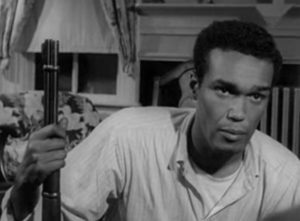Anticipating the Colonial Apocalypse: Jeff Barnaby’s Blood Quantum
This article considers how Jeff Barnaby’s Indigenous zombie feature Blood Quantum, released online during the COVID-19 pandemic, underscores longstanding Indigenous viewpoints which anticipate the tensions magnified by this crisis. Drawing on the film’s reception in the media as well as interviews with creative personnel, this essay frames its analyses within Indigenous theoretical paradigms while mobilizing the feminist concept of “epistemic privilege.” Thus, it argues that Blood Quantum, partly through intertextual allusions to earlier anti-racist horror cinema, highlights the convergence of Indigenous responses to colonialism with interventions that oppose anti-Black racism. In addition, this essay finds that Blood Quantum innovates with genre in ways that mirror the emphasis placed in reciprocity by Indigenous thinkers, while firmly rejecting the recentering of Indigenous struggles around white allyship. Although Blood Quantum succeeds in stressing the crucial significance of Indigenous perspectives for contesting injustices compounded by COVID-19, miscomprehension yet remains about the link between the lived realities of Indigenous peoples and the film’s aesthetic choices. This essay concludes that such persistent biases confirm the vital urgency of ensuring the increased prominence and broad influence of Indigenous viewpoints to counter the homogenizing tendency of Eurocentric culture.
Introduction
Mi’kmaw director Jeff Barnaby’s much anticipated second feature Blood Quantum portrays an apocalyptic contagion in a strikingly topical way. Premiering at the Toronto International Film Festival in 2019, its theatrical release, planned for spring 2020, was canceled due to the COVID-19 pandemic. Nevertheless, Blood Quantum, fully exploiting the allegorical potential of the zombie subgenre, remarkably echoes current global health and political crises. Premised on the spread of a horrific disease that turns non-Indigenous people into zombies but to which Indigenous people are immune, the film’s narrative, coupled with an online release coincident with racial tensions in the wake of COVID-19, intensifies engagement with the history and legacy of colonialism in North America. As such, Blood Quantum illuminates the crucial significance of Indigenous perspectives for contesting flawed hegemonic social and political structures, and urges viewers to more incisively critique the bases of colonial violence long denounced by Indigenous artists, scholars, activists, and leaders.
Set in 1981 on a fictional reserve that stands in for Barnaby’s home community of Listuguj, which was raided by Québec provincial police that same year, Blood Quantum builds on this historical moment.[1] This approach correlates with patterns observed by Grace L. Dillon, who notes that Indigenous genre authors often imagine alternate histories to “well-known cataclysms” where historical circumstances are inverted, with Indigenous figures either coming out as victors or at least being at the center of the narrative (9). In Barnaby’s case, the 1981 Restigouche raids clearly correspond to such an event and are combined in Blood Quantum with the history of decimating epidemics following Indigenous encounters with Europeans. In the film, Indigenous characters, led by Traylor, the reserve’s head of police, Joss, his ex-partner and mother of his youngest son Joseph, and Traylor’s father Gisigu, a sword-wielding elder, do battle with the zombified white population and struggle to deal with white survivors seeking refuge on their territory. In parallel, the group also contends with internal discord catalyzed by Lysol, Traylor’s troubled older son from a previous relationship, who opposes the accommodation of white survivors. By deploying the zombie, a figure associated with the history of Black enslavement, Blood Quantum aligns itself with other non-white peoples oppressed by European colonialism, a move consistent with Leanne Betasamosake Simpson’s call for Indigenous activists to form “constellations of co-resistance with other movements,” including “radical communities of color” (27). Meanwhile, Blood Quantum focusses firmly on a struggle over land in accordance with Glen Coulthard’s concept of “grounded normativity,” which emphasizes connections between land, knowledge, and ethical relationships (13). Thus, drawing on the film’s reception in the media and interviews with creative personnel, this essay argues that Blood Quantum’s basis in Indigenous thought, redeployment of genre, and thematic relevance highlight the perspicuity of Indigenous concerns and the vital importance of scholarly, pedagogical and cultural spaces that center on and heed unobstructed Indigenous viewpoints and epistemologies.
Epistemic Privilege
Several film critics describe Blood Quantum’s unsettling relevance as “timely” or “prescient” (Crucchiola, Tallerico, Yamato), but the film rearticulates core ideas long held by Indigenous scholars, leaders, and artists. Accordingly, though he acknowledges the film’s timing in terms of reflecting the current sociopolitical moment, Barnaby himself distinguishes this from prescience. “What I am doing here isn’t even prescient,” he explains, “because it’s a pulse that was already in the culture. It’s always been in the culture” (Bramesco). Indeed, global human and environmental crises anticipated by Barnaby’s film constitute lived reality for Indigenous peoples. The film thus brings perspective to the broader effects of the COVID-19 pandemic. Barnaby downplays Blood Quantum’s insight in anticipating the wide-ranging consequences of the virus as a mere reflection of longstanding Indigenous realities (Monkman), and points out that “what’s interesting about this virus is … it’s the way Native people have always lived. It’s nothing new for a Native community to face record unemployment while at the same time dealing with large amounts of diseases” (Crucchiola). Indeed, Dillon’s analysis of Indigenous futurism confirms that “it is almost commonplace to think that the Native Apocalypse, if contemplated seriously, has already taken place” (8). Likewise, Simpson describes her own nation’s experience of colonialism as “four centuries of apocalyptic violence in the name of dispossession” (21). Echoing these views, Michael Greyeyes, who plays Traylor in Blood Quantum, describes the colonial settler state as “another kind of apocalypse,” noting that “his community knows only too well what it feels like to fight against annihilation.” Elle-Máijá Tailfeathers, who plays Joss, concurs with Greyeyes. Indigenous people live with “the daily reality of state-sanctioned systemic violence,” she explains, “zombie apocalypse or not, our realities wouldn’t be all that different” (Wong). And, although some critics fail to comprehend the film’s dialogue and acting choices (Ehrlich, Hertz, Tallerico), others recognize the appropriateness of Indigenous actors’ performances, acknowledging, for example, that Traylor’s father Gisigu (Stonehorse Lone Goeman) reacts to events in a manner that is suitably horrified, yet composed, evidence that this elder has “seen and survived plenty before zombies” (Yamato). As Greyeyes summarizes, “We’re survivors. We totally get it …. Who would be the best survivor in an actual apocalypse? Us” (Wong).
Fig. 1: Gisigu (Stonehorse Lone Goeman), composed as he prepares to defend the land against white zombies (Blood Quantum (2019), Jeff Barnaby).
These views speak to the notion of “epistemic privilege,” which, contrary to economic, social, and political privilege, transpires as the possession of a deep understanding of systemic inequalities through one’s material disadvantages and the lived experience of discrimination. The concept of epistemic privilege was developed most notably by feminist standpoint theorists and applies to any marginalized group. Starting from the basis that knowledge is socially situated, it posits that the lived experiences of marginalized groups enable them to discern the deep structural patterns of systems that oppress them, which tend to remain invisible to those in positions of social, political, and economic privilege. Thus, according to Sandra Harding, “standpoint theories map how a social or political disadvantage can be turned into an epistemological, scientific, and political advantage” (7–8). Blood Quantum combines this idea with an innovative take on the zombie movie that links it to analogous Black struggles. Indeed, the film recollects and builds on the resourcefulness attributed to Ben (Duane Jones), the Black hero of George A. Romero’s classic Night of The Living Dead (1968). Like his Indigenous counterparts in Blood Quantum, Ben proves better equipped than white characters to withstand the zombie apocalypse, having personally experienced the legacy of slavery. Likewise, in Barnaby’s own allegory, Indigenous characters have developed a physical immunity to the contagion, presumably due to their prior exposure to colonialism and its ongoing iterations. No Black characters appear in Blood Quantum, just as no characters from other non-white groups appear in Night of the Living Dead. Yet, Romero’s film has been compellingly read as a critique of other forms of oppression and imperialism due to the sociopolitical context of its release (the same year as the Tet offensive in Vietnam, and of the assassinations of Martin Luther King Jr. and Robert Kennedy), and also because of the interconnectedness of class and ethnic conflicts implied by the film, as well as an “absent presence” of other oppressed peoples in its narrative and aesthetics (Higashi). By extension, the absence of non-Indigenous, non-white characters in Blood Quantum reciprocates Romero’s far-reaching condemnation of white supremacy. Thus, Blood Quantum’s implicit reference to its legendary precursor suggests co-resistance against European colonialism manifested as hordes of ravenous white zombies.
Fig. 2: Ben (Duane Jones), better equipped than white characters to withstand the zombie apocalypse (Night of the Living Dead (1968), George A. Romero).
Indigenous Reciprocity
Eurocentrism posits western knowledge as inherently superior, obscures its own contradictions, and encourages intrinsically dehumanizing attitudes that preclude reciprocity (Shohat and Stam 1-3). Its limitations prove not only destructive to those it oppresses, but also to itself. In contrast, many Indigenous thinkers value reciprocity for sustainable life. In Red Skins, White Masks, Coulthard draws on anticolonial thinker Frantz Fanon and adapts Marxist theory, rendering the latter compatible with core Indigenous principles. These enriching exchanges mirror Barnaby’s genre innovations. Both Blood Quantum and Night of the Living Dead depict the warning Jean-Paul Sartre directs to Europeans in his introduction to Fanon’s The Wretched of the Earth. “In these shadows from whence a new dawn will break, it is you who are the zombies” (1963, 13), Sartre writes. But Blood Quantum enhances the portrayal of (self-)destructive and (self-)dehumanizing colonialism. Shifting the emphasis of Marxism, Coulthard specifies that the settler state primarily targets Indigenous land over Indigenous labor, and that Indigenous struggles are “not only for land in a material sense, but also deeply informed by what the land as a system of reciprocal relations and obligations can teach us about living our lives in relation to one another and the natural world in nondominating and nonexploitative terms” (13). Blood Quantum dramatizes this conflict as white survivors covet reserve space above the bodily protection afforded by their Mi’kmaw hosts. Survivors hide the truth to enter the reserve as an emergency measure, not as an opportunity to fundamentally redefine their relationship to the land and others. This epitomizes the west’s persistent unwillingness to discern and genuinely tackle the root cause of global crises. Indeed, white survivors and some Mi’kmaq, like Traylor’s oldest son Lysol (Kiowa Gordon), replicate the brutality of the colonial system, and end up polluting Indigenous territory as a last viable refuge.
Fig. 3: Lysol’s (Kiowa Gordon) anger, though warranted, comes to replicate colonial brutality (Blood Quantum (2019) Jeff Barnaby).
By continuing to ignore and suppress Indigenous ideas, Blood Quantum suggests, the Eurocentric capitalist and colonialist worldview, unless effectively countered by the very epistemologies it occludes, will destroy itself and others. This aspect of the film’s social commentary echoes recent real-world conflicts such as the Wetʼsuwetʼen land defenders’ protests against the Coastal GasLink Pipeline through unceded Indigenous territory in British Columbia, a project oxymoronically justified as ecologically progressive (“Trudeau Touts”), and coercively enforced by the Royal Canadian Mounted Police, an organization that has now finally acknowledged its own systemic racism (Ballingall, Walsh). Indeed, it is telling that certain conservative politicians see the COVID-19 pandemic as a unique opportunity to press on with pipeline building unimpeded by protestors during confinement (“Minister Says”). Seemingly mirroring such issues, Blood Quantum memorably visualizes elders’ struggles to protect the land when, in his final scene, Gisigu refuses to abandon Mi’kmaw territory again and, filmed in a long shot that emphasizes his tenacious struggle against overwhelming odds, single-handedly battles a swarm of zombies.
Implicating Non-Indigenous Viewers, Decentering White Narratives
Barnaby does not underestimate white society’s stubborn refusal to recognize the need for spaces where Indigenous knowledge can flourish unimpeded. Indeed, his hard-hitting style and adoption of the zombie subgenre astutely communicate, through irony and excess, the destructive contradictions of Eurocentrism and the imperative to listen to Indigenous ideas. Barnaby openly expresses his desire to deploy genre filmmaking to reach “younger and broader audiences,” and admits to deliberately instrumentalizing the current hyperpopularity of the zombie film to encourage viewer engagement with difficult issues, both historical and ongoing (Black). Indeed, the premise of Blood Quantum is inherently edifying. As lead actor, Michael Greyeyes recognizes, the “idea that colonial history has been reenacted subversively is a message that even the most non-political, non-socially informed person will understand right away” (Yamato). At the same time, Blood Quantum heeds Simpson’s warning against recentering Indigenous struggles around white allyship (30). Non-Indigenous characters remain largely peripheral. Only Charlie, the pregnant girlfriend of Traylor’s and Joss’s teenage son Joseph, takes up significant narrative space. Barnaby’s initial difficulties in getting his project funded (Lipsett, Wong), however, reflect an ongoing reluctance to support Indigenous-centered stories.[2] Commenting on why he found no takers when he proposed the project to financiers in 2007, Barnaby explains that “nobody was ready to hear that the great capitalist dream was falling apart and colonialism was going to help usher us into destruction. So it was the culture that took catching up to the script. Nothing changed, just the cultural perception of it” (Yamato). In Blood Quantum, signs of an attitudinal change are barely perceptible. Only in Charlie’s dying moments do we sense a recognition of the West’s absurd self-destructiveness. Having just given birth to a daughter, but doomed to die of a zombie bite, Charlie protects the child from herself by handing her over to Joseph and Joss. Charlie then asks to be killed before turning into “one of those dead people.” Her child’s entrustment to its Indigenous family ironically upturns Canada’s genocidal education and childcare policies, a reversal that is underscored in the film’s final shot of Joss holding the baby.[3] Here, it is white society that is deemed “unfit” to educate the next generation. Hope for humanity amid the chaos rests partly on the decentering of whiteness signaled by Charlie’s self-effacement.
Fig. 4: Joss (Elle-Máijá Tailfeathers) holding her newborn granddaughter. (Blood Quantum (2019), Jeff Barnaby).
Conclusion
With Blood Quantum, Barnaby reiterates viewpoints long-expressed by Indigenous commentators, but his innovations with genre and their implicit alignment with co-resistant communities find new ways of challenging western assumptions about the political crises surfacing with global pandemics like COVID-19. In his own words, Barnaby Indigenizes horror (Bramesco). However, not all mainstream critics understand or welcome the stylistic imperatives of these innovations. Unused to sharing communicative space with works anchored in other traditions, these critics blame the author’s creative choices for their own inability to follow narrative patterns or empathize with characters (Ehrlich, Hertz, Tallerico, Vincentelli). Such dissent doubtless rests in part with a disproportionate investment in individualism rather than on reciprocity, and with a lack of awareness of the lived realities of marginalized groups. Barry Hertz, for example, reproaches Barnaby for overemphasizing Lysol’s complexity, and describes this antagonist as a “side character,” thereby failing to grasp Lysol’s centrality to the film’s exploration of the legacy of colonial policies. Astonished that certain viewers fail to understand the motivations for Lysol’s anger even though the film makes clear this character’s traumatic experience of the childcare system (Crucchiola), Barnaby elaborates on the considerable burden of informing non-Indigenous audiences about the historical roots of colonialism and white privilege. “A lot of people are not ‘getting’ the film because they don’t know the contextual history underlying the ideas,” he observes. “That’s always the issue when you’re dealing with a non-Native audience; they’re not going to understand where you’re coming from” (Black). In contrast with the above-mentioned commentators who divorce their appraisal of the film from anything beyond a superficial understanding of its historical resonance, Joe Lipsett, whose article probes the historical and sociopolitical significance of the film more incisively, praises its character development as well-crafted and its performances as compelling and soliciting audience investment. Thus, although meaningful understanding of Indigenous narrative and its aesthetic logic is attainable for viewers open to non-hegemonic worldviews and approaches, continued miscomprehension only confirms the urgent need to counter the homogenizing tendency of Eurocentric culture.
Meanwhile, Blood Quantum also signals its solidarity with parallel interventions opposing anti-Black and other forms of racism. Tellingly, not only is Lysol a character whose complexity exposes him to being misunderstood, he is also the character who most explicitly articulates co-resistance with non-white allies when he stresses the threat posed by white survivors seeking shelter and describes them as “never [having] seen a brown person since their grandparents owned one.” In light of recent Black Lives Matter protests, fueled also by the exposure of racial injustice during COVID-19, this alignment further augments the film’s apparent prescience. And while enduring Eurocentric stereotypes of Indigenous ghosts tend to mobilize such supernatural figures as a way to “disappear” Indigenous presence from the territory now known as North America, for Michelle Raheja, works by Indigenous artists deploying Indigenous ghosts conversely “draw attention to the embodied present and future” of Indigenous peoples (146). As such, even though Blood Quantum engages with the zombie rather than the ghost, the clairvoyance attributed to this film appears to correlate with Raheja’s theorization of Indigenous prophecy. Indeed, Blood Quantum combines the zombie’s origins in the idea of eternal Black slavery with the parallel idea of eternal Indigenous dispossession. Appropriating both of these tropes, Blood Quantum instead casts the white population as eternally (self-)enslaved to boundless systems of accumulation and (self-)dispossessed of the rich reciprocal possibilities of learning from non-western epistemologies.
References
Ballingall, Alex. 2020. “Top Mountie Now Says ‘Systemic Racism’ Exists.” Toronto Star, June 13. http://search.ebscohost.com.res.banq.qc.ca/login.aspx?direct=true&db=rch&AN=6FPTS2020061358164235&lang=fr&site=ehost-live. Accessed August 26, 2020.
Black, Sarah-Tai. 2020.“The History and Horror of Blood Quantum.” The Globe and Mail, April 28, 2020. https://search-proquest-com.res.banq.qc.ca/docview/2395170352?accountid=8612. Accessed August 26, 2020.
Bramesco, Charles. 2020. “’I’m indigenizing zombies’: behind gory First Nation horror Blood Quantum.” The Guardian, April 28. https://www.theguardian.com/film/2020/apr/28/blood-quantum-horror-film. Accessed August 26, 2020.
Comentale, Edward P. 2017. “Zombie Race.” In Zombie Theory: A Reader, ed. Sarah Juliet Lauro, 189-211. University of Minnesota Press.
Coulthard, Glen Sean. 2014. Red Skin, White Masks: Rejecting the Colonial Politics of Recognition. University of Minnesota Press.
Crucchiola, Jordan. 2020. “Jeff Barnaby Made an Apocalypse Movie to Watch the System Fall. Then a Pandemic Hit.” Vulture, May 6. https://www.vulture.com/2020/05/jeff-barnaby-is-worried-white-people-wont-get-blood-quantum.html. Accessed August 26, 2020.
Dillon, Grace L. 2012. “Imagining Indigenous Futurisms.” Walking the Clouds: An Anthology of Indigenous Science Fiction. 1-12. Ed. Grace L. Dillon. University of Arizona Press.
Ehrlich, David. 2020. “‘Blood Quantum’ Review: Indigenous Canadian Zombie Movie Bites Into Colonialism.” IndieWire, April 28. https://www.indiewire.com/2020/04/blood-quantum-review-indigenous-canadian-zombie-movie-1202227657/. Accessed August 26, 2020.
Hanson, Erin. 2009. “Sixties Scoop.” UBC Indigenous Foundations. http://indigenousfoundations.arts.ubc.ca/sixties_scoop/. Accessed August 26, 2020.
Harding, Sandra. 2004. “Introduction: Standpoint Theory as Site of Political, Philosophic, and Scientific Debate.” In The Feminist Standpoint Theory Reader: Intellectual and Political Controversies, ed. Sandra Harding. 1-16. New York; London: Routledge.
Hertz, Barry. 2020. “And Now, a Zombie Movie with Brains: Review.” The Globe and Mail, May 1. https://search-proquest-com.res.banq.qc.ca/docview/2396592268?accountid=8612. Accessed August 26, 2020.
Higashi, Sumiko. 1990. “Night of the Living Dead: A Horror Film about the Horrors of the Vietnam Era.” In From Hanoi to Hollywood: The Vietnam War in American Film, ed. Linda Dittmar and Gene Michaud, 175-188. Rutgers University Press.
Lipsett, Joe. 2020. “Shudder’s Indigenous Zombie Film ‘Blood Quantum’ is Entertaining AND Important.” BloodyDisgusting, April 29. https://bloody-disgusting.com/reviews/3582496/tiff-review-indigenous-zombie-film-blood-quantum-entertaining-important/. Accessed August 26, 2020.
Monkman, Lenard. 2020. “Indigenous zombie film Blood Quantum available soon to watch online.” CBC News, April 27. https://www.cbc.ca/news/indigenous/blood-quantum-film-online-release-1.5546743. Accessed August 26, 2020.
Raheja, Michelle H. 2011. Reservation Reelism: Redfacing, Visual Sovereignty, and Representations of Native Americans in Film. University of Nebraska Press.
Sartre, Jean-Paul. 1963. “Preface” to The Wretched of the Earth by Frantz Fanon, 7-30. Trans. Constance Farrington. New York: Grove Weidenfeld.
Shohat, Ella, and Robert Stam. 1996. Unthinking Eurocentrism. Routledge.
Simpson, Leanne Betasamosake. 2016. “Indigenous Resurgence and Co-resistance.” Critical Ethnic Studies 2.2: 19-34.
Tallerico, Brian. 2020. “Blood Quantum.” RogerEbert.com, April 28. https://www.rogerebert.com/reviews/blood-quantum-movie-review-2020. Accessed August 27, 2020.
The Globe and Mail. 2020. “Minister Says ‘Now is a Great Time’ to Build Pipelines, as Health Rules Limit Protests.” May 26. https://search-proquestcom.res.banq.qc.ca/docview/2406456149/fulltext/D6A6C5B4FCF6440DPQ/1?accountid=8612. Accessed August 27, 2020.
The Vancouver Sun. 2019. “Trudeau Touts Controversial Pipeline Project in Speech to Supporters in B.C.” January 9. The Vancouver Sun Online. Postmedia Network Inc. https://search-proquest-com.res.banq.qc.ca/docview/2165846840?accountid=8612. Accessed August 27, 2020.
Truth and Reconciliation Commission of Canada. 2015. Canada’s Residential Schools: The Final Report of the Truth and Reconciliation Commission of Canada. Vol. 1. McGill-Queen’s Press-MQUP. https://nctr.ca/reports2.php.
Vincentelli, Elisabeth. 2020. “‘Blood Quantum’ Review: Inspired Splatter” New York Times, April 28. https://www.nytimes.com/2020/04/28/movies/blood-quantum-review-inspired-splatter.html. Accessed August 27, 2020.
Vowel, Chelsea. 2016. “Our Stolen Generations: The Sixties and Millennial Scoops.” In Indigenous Writes: A Guide to First Nations, Métis, and Inuit Issues in Canada,181-190. Portage & Main Press.
Walsh, Marieke, Daniel LeBlanc, and Carrie Tait. 2020. “RCMP Say Systemic Racism Exists in Force.” The Globe and Mail, June 13. https://search-proquest-com.res.banq.qc.ca/docview/2412468082?accountid=8612. Accessed August 27, 2020.
Wong, Jessica. 2019. “Blood Quantum’s Indigenous actors totally get the zombie apocalypse.” CBC News, September 10. https://www.cbc.ca/news/entertainment/tiff2019-bloodquantum-1.5273257. Accessed August 27, 2020.
Yamato, Jen. 2020. “How indigenous zombie horror film ‘Blood Quantum’ became prescient in the pandemic.” Los Angeles Times, May 8. https://www.latimes.com/entertainment-arts/movies/story/2020-05-08/blood-quantum-indigenous-horror-zombie-pandemic-jeff-barnaby. Accessed August 27, 2020.
Filmography
Blood Quantum (Jeff Barnaby, 2019)
Incident at Restigouche (Alanis Obomsawin, 1984)
Night of the Living Dead (George A. Romero, 1968)
Notes
[1] On June 12 and 20, 1981, Québec minister for Recreation, Hunting and Fishing Lucien Lessard ordered two provincial police raids on the Mi’kmaw community of Listuguj, aiming to forcibly limit their fishing activities. These events are documented in the 1984 NFB documentary Incident at Restigouche by celebrated Abenaki filmmaker Alanis Obomsawin. Barnaby has credited Obomsawin’s work, and this film in particular, as having had a profound impact on his filmmaking career.
[2] In spite of these initial difficulties, Blood Quantum was announced as boasting “the largest-ever production budget for an Indigenous film in Canada,” according to a 2019 imagineNATIVE report (Black).
[3] Residential schools formed a central part of Canada’s policy to assimilate all Indigenous people (an aim explicitly stated in 1920 by Duncan Campbell Scott, Deputy Minister of Indian Affairs). This system forcibly separated Indigenous children from their families and communities, placing them in church-run institutions often located at great distances away from their homes, and exposing them to institutionalized neglect, physical and sexual abuse, and high death rates. It is estimated that 150,000 Indigenous children attended residential schools in Canada from 1883 to the late 1990s (Truth and Reconciliation Commission 4). The “Sixties Scoop” is the term popularly attributed to the disproportionate, and largely non-consensual, removal of Indigenous children from their families into provincial childcare, foster care, and adoption programs, a phenomenon intensified in the 1960s but not limited to this decade, and which arguably continues today (Hanson, Vowel).



